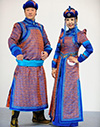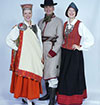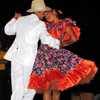Home
 Tanzanian clothing traditions speak of modesty, brightness, and ancient customs. For a European, the first impression from a folk dress of Tanzania sometimes is like “too much”. Too many layers of cloth wrapped helter-skelter around the body, too many colors and patterns, too many weird jewels, etc. But if you take a closer look, you’ll notice the harmony and unicity of a Tanzanian folk costume. The locals feel absolutely comfortable wrapped in their colorful fabrics and beaded adornments.
Tanzanian clothing traditions speak of modesty, brightness, and ancient customs. For a European, the first impression from a folk dress of Tanzania sometimes is like “too much”. Too many layers of cloth wrapped helter-skelter around the body, too many colors and patterns, too many weird jewels, etc. But if you take a closer look, you’ll notice the harmony and unicity of a Tanzanian folk costume. The locals feel absolutely comfortable wrapped in their colorful fabrics and beaded adornments.
- Details
- Category: Tanzania
- Hits: 100386
 Ukrainian traditional clothing is rather diverse. The festive outfits are always colorful and rich in embroidery and bright decorations. But there are certain regional features that help to distinguish the attires according to the area of origin. Here you are the collection of the folk costumes from different regions of Ukraine that belongs to the Museum of Ethnography and Crafts in Lviv (western Ukraine).
Ukrainian traditional clothing is rather diverse. The festive outfits are always colorful and rich in embroidery and bright decorations. But there are certain regional features that help to distinguish the attires according to the area of origin. Here you are the collection of the folk costumes from different regions of Ukraine that belongs to the Museum of Ethnography and Crafts in Lviv (western Ukraine).
- Details
- Category: Ukraine
- Hits: 44954
 Serbia is a curious country from the point of view of the folk costume. Serbian traditional clothing is diverse and beautiful. There is no single national outfit iconic for the whole country. Many various ethnic groups live in Serbia; therefore, their clothing traditions get entwined. It is really interesting to observe the regional features of folk attires. All of the costumes typical for different areas of Serbia are charming.
Serbia is a curious country from the point of view of the folk costume. Serbian traditional clothing is diverse and beautiful. There is no single national outfit iconic for the whole country. Many various ethnic groups live in Serbia; therefore, their clothing traditions get entwined. It is really interesting to observe the regional features of folk attires. All of the costumes typical for different areas of Serbia are charming.
- Details
- Category: Serbia
- Hits: 58888
 Mongolian clothing traditions are very ancient, diverse (because every ethnic group has its own peculiarities), and closely connected with the local lifestyle and climate. The traditional costume of Mongolia is unique and original. You won’t confuse it with any other folk dress. There are, of course, a lot of variations of the national attire according to the region of the country. The greatest diversity is in the shape of a headdress. Some hats are so elaborate and odd that they can easily impress and surprise just about anyone.
Mongolian clothing traditions are very ancient, diverse (because every ethnic group has its own peculiarities), and closely connected with the local lifestyle and climate. The traditional costume of Mongolia is unique and original. You won’t confuse it with any other folk dress. There are, of course, a lot of variations of the national attire according to the region of the country. The greatest diversity is in the shape of a headdress. Some hats are so elaborate and odd that they can easily impress and surprise just about anyone.
- Details
- Category: Mongolia
- Hits: 35461
 Tunisian traditional jewelry pieces are ornate, rather massive, and very beautiful. They are used not just to adorn the costume of a female but as a means of energetic protection, a way of honoring the ancient tradition, and for economic purposes as well. The jewelry collection of a Tunisian woman equals her private bank account. She’s able to manage it as she likes – buy, sell, barter, present or receive as a gift, etc. Vintage jewels are often transmitted within generations of the family. Modern Tunisian women still prefer the traditional jewelry items to ordinary ones used around the world.
Tunisian traditional jewelry pieces are ornate, rather massive, and very beautiful. They are used not just to adorn the costume of a female but as a means of energetic protection, a way of honoring the ancient tradition, and for economic purposes as well. The jewelry collection of a Tunisian woman equals her private bank account. She’s able to manage it as she likes – buy, sell, barter, present or receive as a gift, etc. Vintage jewels are often transmitted within generations of the family. Modern Tunisian women still prefer the traditional jewelry items to ordinary ones used around the world.
- Details
- Category: Tunisia
- Hits: 30792
 Latvian traditional costume is charming, modest, and sophisticated. Female outfits are delicate, very feminine, and have a lot of simple but very fine decorations; while male costumes are polished and noble-looking (Latvian men dressed in full sets of folk clothes make you think of landlords and noble gentlemen). The very first thing you notice in a women’s traditional costume of Latvia is a shawl and an extraordinary headdress, in men’s – a coat and a hat.
Latvian traditional costume is charming, modest, and sophisticated. Female outfits are delicate, very feminine, and have a lot of simple but very fine decorations; while male costumes are polished and noble-looking (Latvian men dressed in full sets of folk clothes make you think of landlords and noble gentlemen). The very first thing you notice in a women’s traditional costume of Latvia is a shawl and an extraordinary headdress, in men’s – a coat and a hat.
- Details
- Category: Latvia
- Hits: 31739
 Ethiopian people still wear their traditional clothes rather often. Older people and the citizens from the rural area use the folk dress every day. Though in large cities, Ethiopians prefer the western-style clothing, they also get their traditional costumes out of the closet during the festivals, weddings, and national celebrations. It’s not just because of clothing traditions and customs, but also the climate and weather conditions of Ethiopia. The folk costumes were designed to fit the peculiarities of this country perfectly, to give locals the protection from the vagaries of weather, and to make them feel comfortable.
Ethiopian people still wear their traditional clothes rather often. Older people and the citizens from the rural area use the folk dress every day. Though in large cities, Ethiopians prefer the western-style clothing, they also get their traditional costumes out of the closet during the festivals, weddings, and national celebrations. It’s not just because of clothing traditions and customs, but also the climate and weather conditions of Ethiopia. The folk costumes were designed to fit the peculiarities of this country perfectly, to give locals the protection from the vagaries of weather, and to make them feel comfortable.
- Details
- Category: Ethiopia
- Hits: 35555
 The traditional costume in Thailand is called “chut thai” (the translation is “Thai dress”). It is charming – bright and delicate, fitting and modest at the same time. But, like many other people in the world, locals seldom use their folk outfit in everyday life. Nevertheless, you can see lots of Thais dressed in the national clothing during the ethnic festivals, celebrations, weddings, and other special occasions. But the most extraordinary chut thai are women’s Thai formal dresses. They totally deserve to be called royal outfits.
The traditional costume in Thailand is called “chut thai” (the translation is “Thai dress”). It is charming – bright and delicate, fitting and modest at the same time. But, like many other people in the world, locals seldom use their folk outfit in everyday life. Nevertheless, you can see lots of Thais dressed in the national clothing during the ethnic festivals, celebrations, weddings, and other special occasions. But the most extraordinary chut thai are women’s Thai formal dresses. They totally deserve to be called royal outfits.
- Details
- Category: Thailand
- Hits: 116863
 Emirati men and women still keep their traditions in the 21st century. They wear the national outfits of the United Arab Emirates every day due to the tradition, religious law, and climate of the country. When Emiratis go abroad they usually prefer to wear the western-style clothing but at home, most of them continue to use kanduras, gutrahs, and abayas. The clothing tradition is very important in the UAE, so tourists should remember about that and respect it, even if we’re not used to wearing such clothes.
Emirati men and women still keep their traditions in the 21st century. They wear the national outfits of the United Arab Emirates every day due to the tradition, religious law, and climate of the country. When Emiratis go abroad they usually prefer to wear the western-style clothing but at home, most of them continue to use kanduras, gutrahs, and abayas. The clothing tradition is very important in the UAE, so tourists should remember about that and respect it, even if we’re not used to wearing such clothes.
- Details
- Category: United Arab Emirates
- Hits: 62630
 The beginning of the 20th century changed women’s fashion very much. Crinolines, wide skirts, corsets, and bustles were gradually replaced by straight-cut dresses, small felt hats, comfy underwear, plenty of lace, and stuffed birds as hat decorations. We offer you a great collection of different outfits from France, USA, Czechia, Ukraine, Russia, etc. used in the 20th century. You definitely should see this fine collection of accessories. All these pieces belong to a Ukrainian collector Marina Ivanova who created the Museum of history of fashion in Ukraine.
The beginning of the 20th century changed women’s fashion very much. Crinolines, wide skirts, corsets, and bustles were gradually replaced by straight-cut dresses, small felt hats, comfy underwear, plenty of lace, and stuffed birds as hat decorations. We offer you a great collection of different outfits from France, USA, Czechia, Ukraine, Russia, etc. used in the 20th century. You definitely should see this fine collection of accessories. All these pieces belong to a Ukrainian collector Marina Ivanova who created the Museum of history of fashion in Ukraine.
- Details
- Category: Nationalclothing
- Hits: 15493
 Modern Venezuelans don’t have a habit to wear the folk clothing every day. They even use it rather seldom on special occasions, such as weddings, national celebrations, and ceremonies. Though Venezuelan national outfit looks not too extraordinary or weird, locals prefer to use the western-style clothing instead of a folk dress. Nevertheless, the traditional costume of Venezuela is pretty and comfy. And it is the cultural heritage of this country, among many other colorful traditions.
Modern Venezuelans don’t have a habit to wear the folk clothing every day. They even use it rather seldom on special occasions, such as weddings, national celebrations, and ceremonies. Though Venezuelan national outfit looks not too extraordinary or weird, locals prefer to use the western-style clothing instead of a folk dress. Nevertheless, the traditional costume of Venezuela is pretty and comfy. And it is the cultural heritage of this country, among many other colorful traditions.
- Details
- Category: Venezuela
- Hits: 177314
 In the 19th century, fashion trends became international. Especially, if to talk about feminine wardrobes. Women used corsets, crinoline, and bustles. Even little girls often were dressed in corsets and bustles. Such accessories as hats and gloves were obligatory. This period is characterized by pompous dresses, intricate accessories, complicated underwear items, and the usage of large amounts of fabric. We offer you a great collection of different outfits from France, USA, Germany, Austria etc. used in the 19th century. All these pieces belong to a Ukrainian collector Marina Ivanova who created the Museum of history of fashion in Ukraine.
In the 19th century, fashion trends became international. Especially, if to talk about feminine wardrobes. Women used corsets, crinoline, and bustles. Even little girls often were dressed in corsets and bustles. Such accessories as hats and gloves were obligatory. This period is characterized by pompous dresses, intricate accessories, complicated underwear items, and the usage of large amounts of fabric. We offer you a great collection of different outfits from France, USA, Germany, Austria etc. used in the 19th century. All these pieces belong to a Ukrainian collector Marina Ivanova who created the Museum of history of fashion in Ukraine.
- Details
- Category: Nationalclothing
- Hits: 20447
Traditional headdresses of Muslim women. Do you know the difference between hijab, niqab, and burqa?
 Did you know that Muslim women have at least 7 different headdresses to cover their heads? Each piece has unique features and is used in certain situations. Some of them are comfier (they can be used even for sports), others are stricter (cover the female body absolutely); a few headgears have a religious purpose (are used for ceremonies and praying), but most pieces are worn by women in day-to-day life. They’re a part of a female everyday attire.
Did you know that Muslim women have at least 7 different headdresses to cover their heads? Each piece has unique features and is used in certain situations. Some of them are comfier (they can be used even for sports), others are stricter (cover the female body absolutely); a few headgears have a religious purpose (are used for ceremonies and praying), but most pieces are worn by women in day-to-day life. They’re a part of a female everyday attire.
- Details
- Category: Nationalclothing
- Hits: 58906
 The national attire of Poland is very colorful, festive, and diverse. Different regions of the country have their own unique features. It’s a pity, folk costumes are very seldom used in a day-to-day life; but Polish people often wear them on special occasions (weddings, ethnic festivals, national celebrations and etc.). The most impressive pieces of Polish national clothing are headdresses. They are unique, very delicate, and sophisticated.
The national attire of Poland is very colorful, festive, and diverse. Different regions of the country have their own unique features. It’s a pity, folk costumes are very seldom used in a day-to-day life; but Polish people often wear them on special occasions (weddings, ethnic festivals, national celebrations and etc.). The most impressive pieces of Polish national clothing are headdresses. They are unique, very delicate, and sophisticated.
- Details
- Category: Poland
- Hits: 83978
Page 64 of 70
